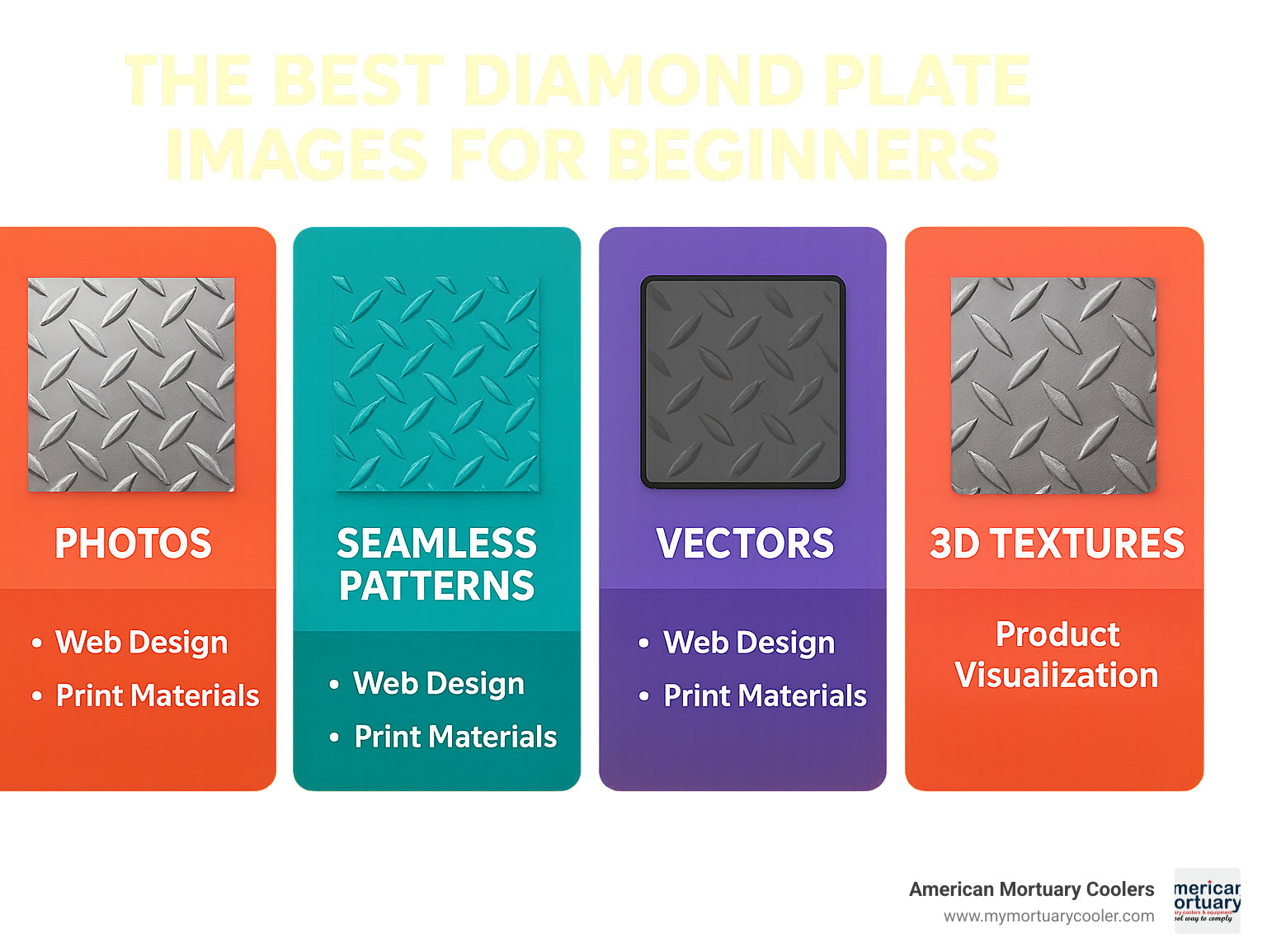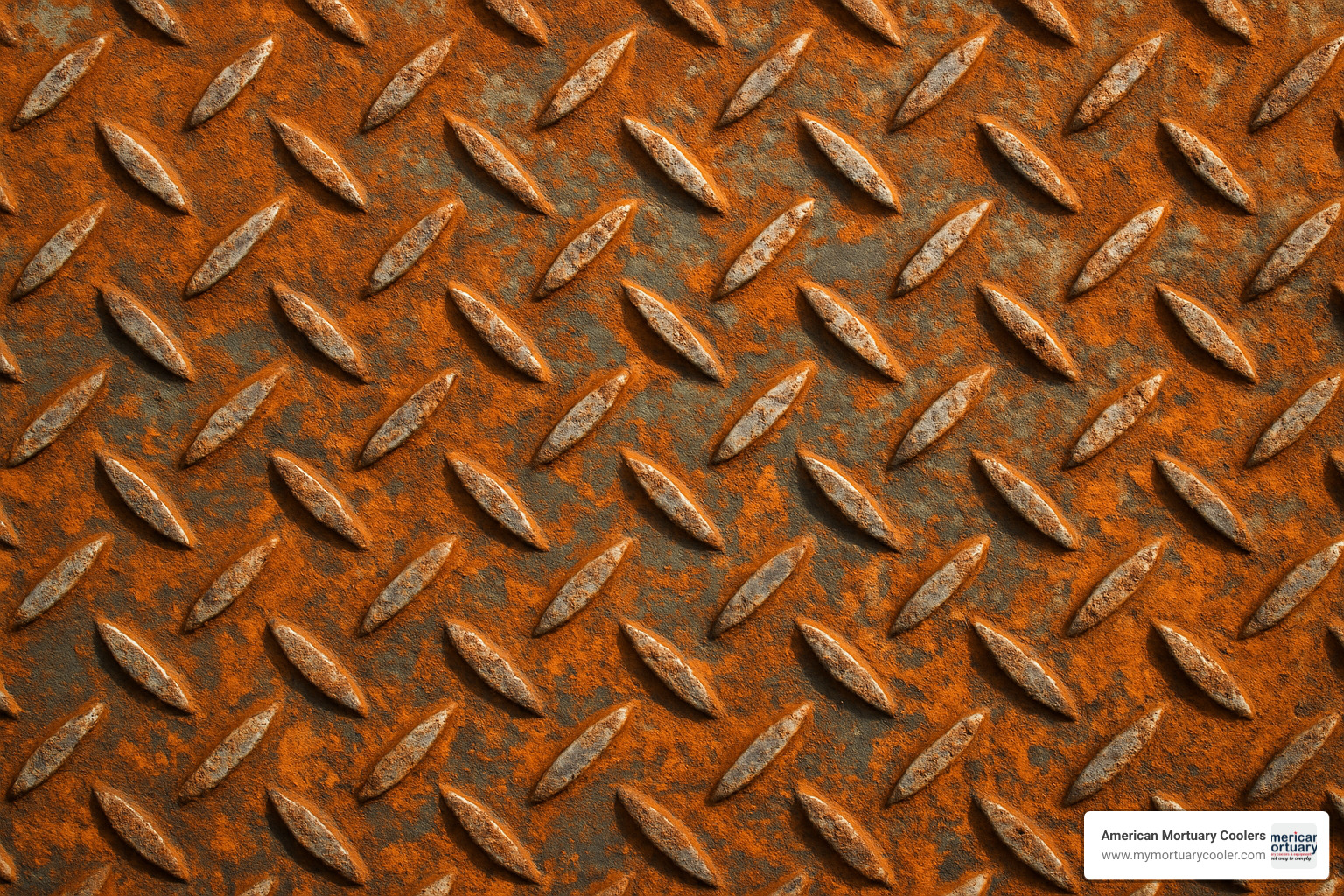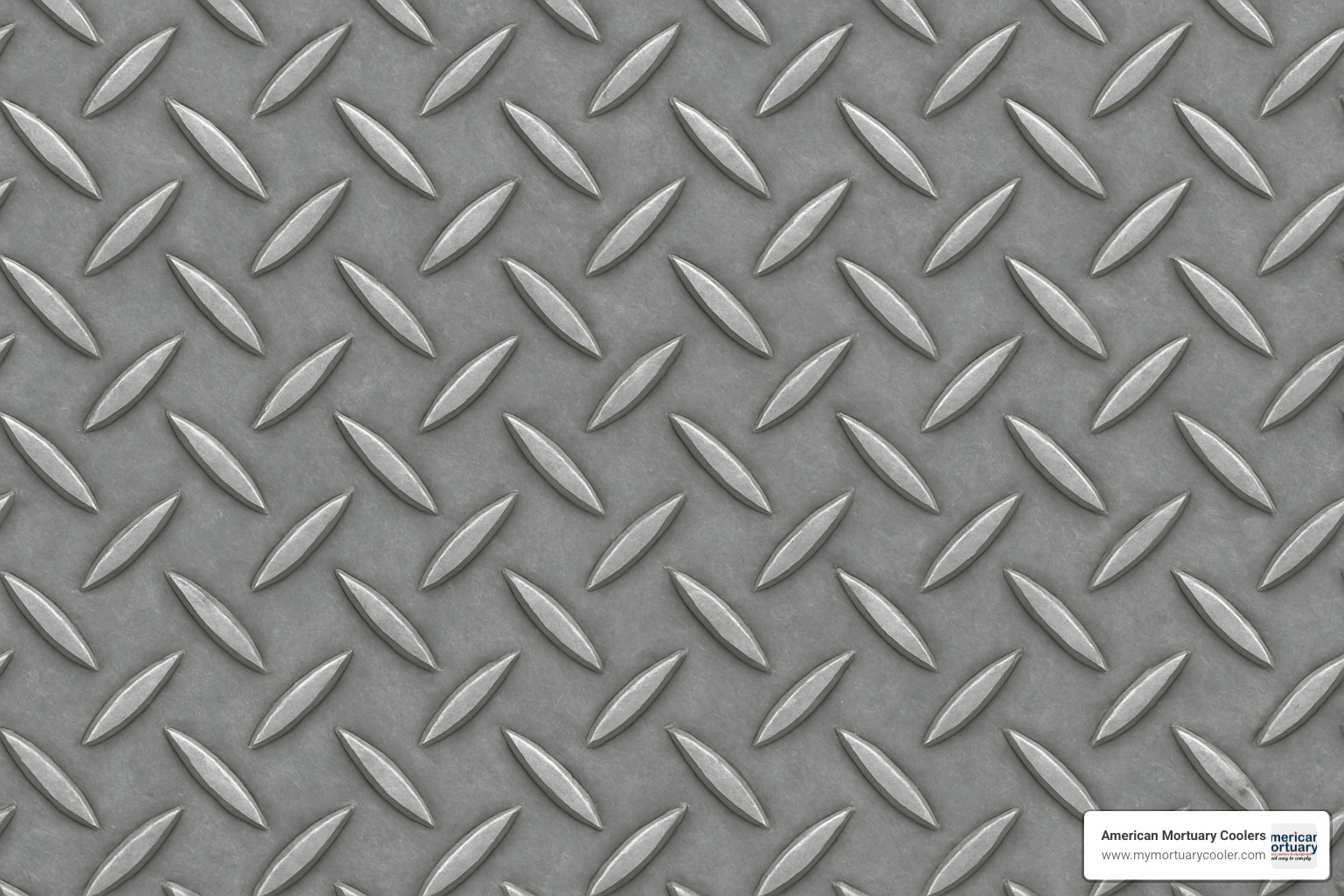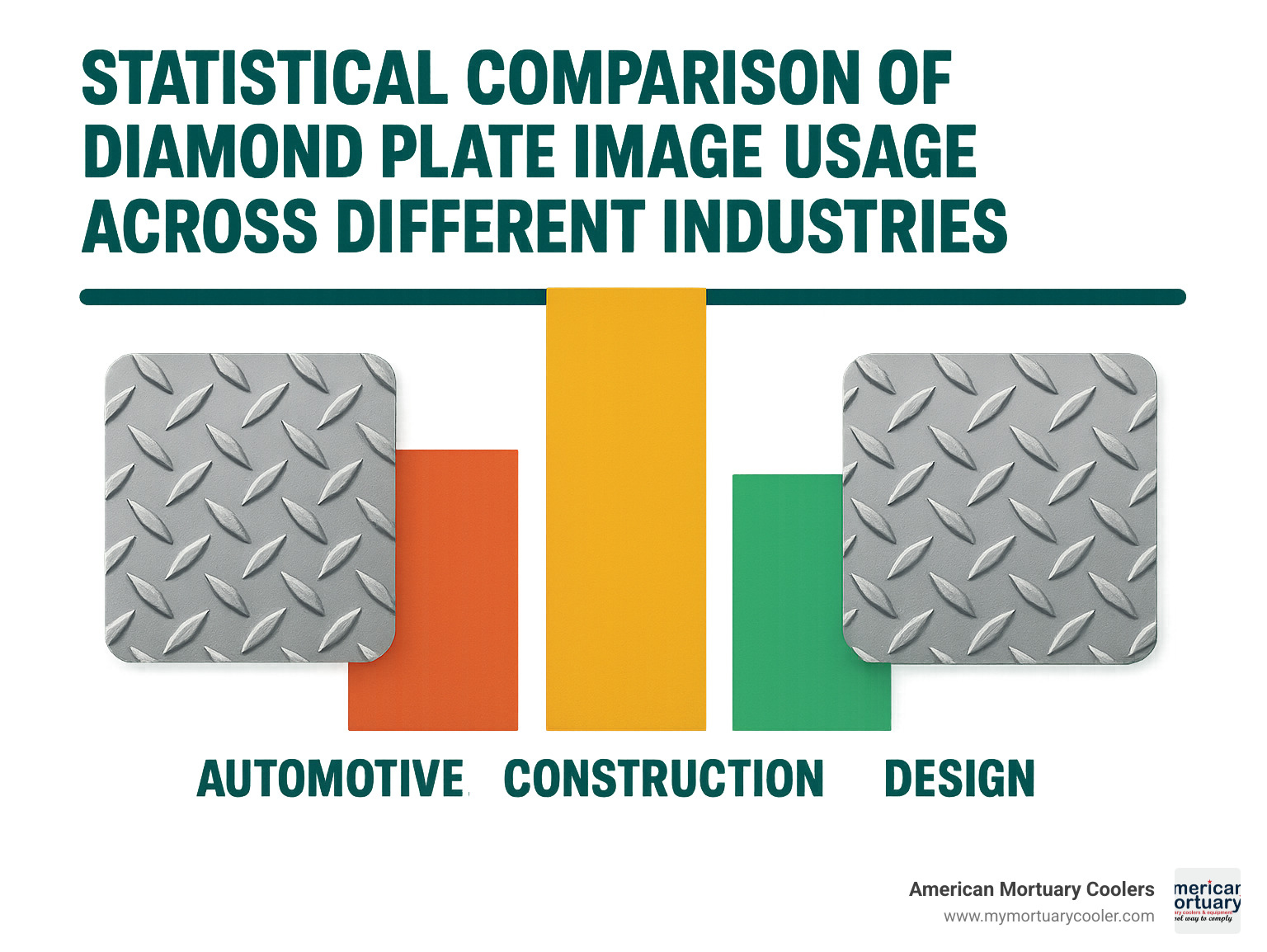
The Best Diamond Plate Images for Beginners
Why Diamond Plate Images Are Essential for Modern Design
Diamond plate images are among the most versatile and recognizable textures in industrial design, featuring raised diamond patterns that create striking visual depth and convey strength, durability, and professional quality.
Top diamond plate image types you can find:
- High-resolution photos - Macro shots showing texture detail and lighting
- Seamless patterns - Tileable backgrounds for web and print design
- Vector graphics - Scalable SVG files with editable colors
- 3D textures - Displacement maps for realistic rendering
- Color variations - Silver, black, chrome, rusty, and custom finishes
The raised diamond pattern isn't just functional for slip resistance - it photographs beautifully under different lighting conditions. Research shows there are over 14,500 diamond plate images available on Adobe Stock alone, with thousands more across platforms like Unsplash, Freepik, and Vecteezy.
Whether you need backgrounds for industrial websites, textures for product mockups, or patterns for print materials, diamond plate images deliver that coveted "industrial chic" aesthetic that communicates reliability and toughness.
I'm Mortuary Cooler from American Mortuary Coolers, where we've worked extensively with diamond plate materials in our mortuary equipment manufacturing for over a decade. My hands-on experience with various diamond plate finishes gives me unique insight into what makes diamond plate images work best for different design projects.

Diamond plate images glossary:
What Is Diamond Plate and Why Does It Photograph So Well?
Picture this: you're walking through an early 1900s factory, and someone's just invented a brilliant solution to all those slippery metal surfaces that were causing accidents. Enter diamond plate - originally called tread plate or checker plate - with its clever raised diamond pattern that grips your boots while letting water and oil drain away.
Fast forward to today, and this practical industrial material has become a photographer's dream. Why? It's all about how those raised diamonds play with light.
Each little diamond acts like a tiny mirror, bouncing light in different directions and creating shadows that shift as you move around. The pattern depth - usually raised about 0.014 to 0.025 inches above the base metal - gives every photo natural dimension and visual weight that flat surfaces just can't match.
This anti-slip surface has become synonymous with toughness and reliability in industrial branding. The geometric precision combined with those light-catching reflections creates images that scream "built to last" - which is exactly why we use diamond plate extensively in our mortuary cooler construction.
Core Materials & Finishes
After working with diamond plate for over a decade at American Mortuary Coolers, I can tell you that each material type has its own personality when it comes to photography.
Aluminum 6061 is the star performer for most applications. This alloy gives you that bright, silvery finish that practically glows under proper lighting. It's lightweight, resists corrosion naturally, and takes powder-coat colors beautifully when you want to branch out from basic silver.
Stainless 304 brings a cooler, more professional vibe to your images. Thanks to its chromium content, it has this subtle matte quality that's actually easier to photograph evenly. We use a lot of stainless in our walk-in coolers because it photographs well under bright LED lighting.
Hot-rolled steel might be the budget option, but don't overlook its photographic potential. When it develops that rusty patina over time, you get these amazing organic textures overlaying the geometric diamond pattern.
The real game-changer has been powder-coat colors. We've seen diamond plate transformed with gloss black finishes that create dramatic contrast, race red that pops in automotive applications, and metallic blue that adds personality to custom projects.
Common Real-World Applications
The beauty of diamond plate is how it shows up everywhere, each application offering unique photographic opportunities.
Stairs and walkways showcase the material's original purpose while creating natural leading lines in photos. Truck beds and toolboxes tell stories of hard work and durability. In our walk-in coolers and freezers, diamond plate serves double duty for hygiene and durability.
Décor panels represent diamond plate's evolution from purely functional to aesthetic, while safety flooring and ramps demonstrate the material's reliability credentials.
| Material Type | Visual Characteristics | Best Photo Lighting | Common Applications |
|---|---|---|---|
| Aluminum 6061 | Bright, highly reflective | Diffused side lighting | Truck beds, decorative panels |
| Stainless 304 | Cool tone, moderate reflection | Even overhead lighting | Food service, medical equipment |
| Hot-rolled Steel | Warm tone, lower reflection | Dramatic angle lighting | Industrial flooring, ramps |
| Powder-coated | Color-dependent reflection | Color-temperature matched | Custom applications, branding |
Types of Diamond Plate Images You Can Download
When you're hunting for the perfect diamond plate images, you'll find an incredible variety of formats to choose from. Our research uncovered over 5,000 royalty-free vector graphics and clipart matching "diamond plate" on Vecteezy alone - and that's just the tip of the iceberg.
Photos are the workhorses of diamond plate imagery. They capture the real-world texture and lighting that makes diamond plate so appealing. Vector graphics are your best friend when size matters. These mathematical wonders scale from postage stamp to billboard without losing a single crisp edge.
Seamless patterns solve the puzzle of covering large areas. These clever designs match perfectly at the edges, so you can tile them endlessly without visible seams. 3D renders offer something photography can't: perfect control. Every highlight is exactly where you want it, every shadow falls just right.
Textures and displacement maps bridge the gap between 2D and 3D. These specialized files work with 3D software to wrap realistic diamond plate surfaces around any shape you can imagine.
Photo & Texture Libraries (High-Res)
High-resolution photography captures something special about diamond plate that other formats just can't match - that tangible, "you can almost feel it" quality. Macro close-ups are particularly stunning, revealing the subtle curves and beveled edges that give each diamond its character.
Silver finishes photograph beautifully when lit properly. The trick is using diffused lighting that prevents harsh reflections while keeping that essential metallic gleam alive. Black diamond plate creates drama through contrast - those raised diamonds catch and reflect light while the valleys stay mysteriously dark.
Chrome finishes can be tricky customers. Their mirror-like surfaces reflect everything, which can create chaos in photos. But when a photographer gets it right, the results are breathtaking.

Grunge and weathered textures tell stories that pristine surfaces simply can't. Every scratch, rust streak, and wear mark adds character and authenticity.
Vector & Seamless Assets for Scalability
Vector diamond plate images solve one of design's most frustrating problems - the dreaded pixelation that happens when you scale raster images. Whether you're creating a tiny business card detail or a massive trade show banner, vectors stay sharp at any size.
SVG files are web design gold. They load fast, scale perfectly, and you can edit them with code if needed. EPS files remain the professional standard for print work. They play nicely with all the major design software and maintain their quality through the entire print production process.
Seamless tiling patterns require mathematical precision to work properly. Every edge must match perfectly with its opposite side, creating invisible repetition across unlimited areas. For specialized applications like vehicle customization, our guide on trailer options covers various diamond plate configurations that might inspire your design choices.
3D & Mockup Resources
3D diamond plate assets have completely changed how we visualize products. OBJ and GLB files contain actual 3D geometry, letting you render diamond plate from any angle with perfect lighting control.
Displacement maps work like magic with 3D software. These grayscale images tell the software exactly how high or low each pixel should be, creating convincing depth and texture on any 3D surface.
Product staging mockups save countless hours and headaches. Instead of setting up elaborate photo shoots, you can place your product on pre-made diamond plate backgrounds with perfect lighting already dialed in.
WebGL backgrounds bring interactive experiences to websites. Visitors can rotate, zoom, and explore the diamond plate texture in real-time, creating engagement that static images simply can't match.
Where to Find the Best Diamond Plate Images
The hunt for perfect diamond plate images can feel overwhelming with so many options available. After years of sourcing materials for our mortuary coolers, I've learned that different platforms excel at different things - and knowing where to look can save you hours of frustration.
Here's a pro tip that's served me well: don't just search for "diamond plate." Try mixing it up with "tread plate," "checker plate," and "metal texture" - you'll be amazed at how different results pop up for what's essentially the same pattern.
Premium Stock Powerhouses
Adobe Stock is the heavyweight champion here, boasting over 14,500 diamond plate results. What I love about their platform is the advanced filtering system - you can narrow down by color, orientation, and even get specific with searches like "chrome diamond plate" (which pulls up over 7,600 results).
Getty Images takes a different approach, focusing on the highest quality professional photography. They guarantee their images are free of AI-generated content, which is becoming increasingly important.
iStock sits in the sweet spot with over 3,400 diamond plate options and excellent search filters. What's practical about iStock is their resolution tiers - you only buy the size you actually need.
Shutterstock rounds out the premium options with competitive pricing and frequent sales. Their contributor community keeps the content fresh, so you'll find diverse perspectives on diamond plate photography.
Free & Community Sources for Diamond Plate Images
Unsplash has become my go-to for high-resolution, free-to-use diamond plate images. Some collections contain over 2,000 textured backgrounds, and the Unsplash License is refreshingly straightforward - you can use them commercially without attribution, though it's nice to give credit when you can.
Freepik offers hundreds of free and premium options, including photos, vectors, and PSD files. The free tier requires attribution, but if you upgrade to premium, that requirement disappears.
For vector graphics specifically, Vecteezy is unbeatable with over 5,000 royalty-free diamond plate vectors. When you need scalable graphics that won't pixelate, this is your best bet.
DeviantArt might surprise you with its community-created content. I've found some unique diamond plate textures there that you won't see anywhere else. One popular texture offers 4500×4500px resolution for free use.
Licensing Tips for Diamond Plate Images
Let's clear up some confusion about licensing - it can save you legal headaches later. Royalty-free doesn't mean free (I know, confusing name). It means you pay once and can use the image multiple times without additional royalties.
The difference between editorial and commercial licensing matters if you're using images for business. Editorial licenses restrict commercial applications, while commercial licenses give you the green light for advertising and promotional use.
Creative Commons licenses are all over the map. CC0 offers the most freedom (essentially public domain), while other CC licenses might require attribution or restrict commercial use entirely.
Always read the fine print - some "free" sites require backlinks, while others limit usage to specific applications or user counts. Trust me, it's worth the five minutes to understand what you're agreeing to.
Creative Ways to Use Diamond Plate Images in Design & Marketing
Diamond plate images have this amazing ability to instantly communicate strength and reliability without saying a word. After years of working with actual diamond plate in our mortuary equipment, I've seen how this pattern translates beautifully into all kinds of creative applications.
The secret is that diamond plate suggests professional competence without being aggressive. It's tough enough for industrial applications but refined enough for modern design work.
Website backgrounds work incredibly well with diamond plate patterns. Unlike busy textures that fight with your content, diamond plate provides just enough visual interest without being distracting.
Social media banners really pop with diamond plate backgrounds. The pattern has natural visual weight that makes your posts stand out in crowded feeds. Plus, it maintains its character even when compressed into tiny thumbnails.
Presentation slides become instantly more engaging with diamond plate textures, especially if you're presenting technical or industrial topics.
Digital Design Tricks
Here's where things get fun. Layer blending modes can completely transform how diamond plate interacts with other design elements. Try Multiply mode to darken underlying colors for a more dramatic look, or Screen mode to lighten things up. Overlay mode is my personal favorite - it increases contrast and makes colors more vibrant.
Opacity masks let you create smooth transitions from textured to clean areas. This technique works beautifully for hero sections where you want the diamond plate to fade gradually into your main content area.
Color overlays can completely change the mood of your diamond plate texture. A blue overlay creates that high-tech, modern industrial feel, while sepia tones give you vintage industrial vibes.
Parallax scrolling brings diamond plate backgrounds to life on websites. When users scroll and the texture moves at different speeds than your foreground content, it creates this engaging sense of depth that keeps people interested.
Print & Product Applications
Vehicle wraps are a natural fit for diamond plate patterns. The automotive heritage just makes sense, especially on trucks, trailers, and commercial vehicles where you want to reinforce that durability message.
Business cards gain serious impact from subtle diamond plate textures. The tactile quality translates surprisingly well to print, adding perceived value that makes your card memorable.
Trade show booths benefit from diamond plate's ability to look substantial and professional. The pattern holds up beautifully in large-format printing, maintaining detail even at billboard sizes.
Product packaging uses diamond plate to instantly communicate durability. We've seen it work exceptionally well for tools, automotive products, and industrial supplies where customers need to trust the quality before they buy.
For specialized applications, you might want to check out our guide on flexible diamond plate for pickup beds, which covers some creative possibilities you might not have considered.
The beauty of diamond plate images is their versatility. Whether you need a subtle texture or a bold statement, this pattern adapts to your needs while maintaining its core message of strength and reliability. For presentation needs, tools like SlidesgoAI Presentation Maker can help you incorporate these textures professionally.
Editing & Customizing Diamond Plate Images Like a Pro
Getting diamond plate images to look exactly right for your project often means rolling up your sleeves and doing some custom editing. The good news? With a few professional techniques, you can transform any diamond plate image into something that perfectly matches your vision.
Photoshop Smart Objects are your best friend for non-destructive editing. When you convert your diamond plate layer to a Smart Object, you can apply filters, adjustments, and effects while keeping the original image data intact.
For vector work, Illustrator Pattern Swatches turn individual diamond plate designs into seamless repeating patterns. Simply select your vector artwork and drag it straight into the Swatches panel, then choose "Pattern."
Texture upscaling has gotten incredibly sophisticated with AI tools like Magnific AI. These tools can take a low-resolution diamond plate image and dramatically increase its size while actually improving detail quality.
Quick Color Variations
Silver remains the gold standard for diamond plate. To improve silver tones, try increasing contrast slightly and adding just a hint of blue to the highlights. This mimics how real aluminum reflects light.
Gloss black creates some of the most dramatic diamond plate effects. The key is creating strong contrast between the raised diamonds that catch light and the recessed areas that stay dark.
Race red and other bold colors require a light touch. Over-saturated colors look artificial on metal surfaces. The trick is keeping the saturation subtle enough that it still reads as metal, not plastic.
Metallic blue walks a fine line between striking and believable. Too much blue saturation looks fake, while too little just appears gray. Aim for a subtle color shift that seems to change with viewing angle.
Gradient overlays add depth and visual interest to flat diamond plate images. Linear gradients work beautifully for large background areas, while radial gradients can simulate realistic lighting effects.
Making Seamless Backgrounds
Creating seamless diamond plate backgrounds takes some patience, but the professional results are worth the effort. The goal is achieving randomness within repetition - your pattern should tile perfectly while avoiding obvious geometric repetition.
The Offset Filter is your diagnostic tool for finding seam problems. Apply it at half your image dimensions in both directions, and any seams will appear right in the center where they're much easier to spot and fix.
Clone Stamp repairs those obvious seams by sampling from similar areas of the image. Work at 100% magnification for precise alignment, and use a hard-edged brush for crisp diamond edges.
Test tiling frequently as you work - it saves hours of frustration later. Create a new document four times larger than your pattern and tile it 2×2 to check for obvious repeats or visible seams.

The most convincing seamless backgrounds feel random even though they're mathematically precise. Each tile should blend invisibly with its neighbors while maintaining the industrial character that makes diamond plate so appealing.
Frequently Asked Questions about Diamond Plate Images
When we talk to designers and business owners about diamond plate images, the same questions come up repeatedly. Having worked with diamond plate materials for over a decade in our mortuary equipment business, I've learned these answers through real-world experience.
What resolution do I need for large-format printing?
The magic number for large-format printing is 150 DPI at final size, though 300 DPI gives you that extra crisp quality for close-up viewing. Here's what that means in real terms: if you're printing a 4×8 foot banner, you'll need an image that's at least 7200×14400 pixels at 150 DPI.
The good news? Diamond plate is surprisingly forgiving compared to regular photos. The geometric pattern actually helps hide pixelation, so you can sometimes get away with slightly lower resolutions.
Vector formats are your best friend for large printing. SVG and EPS files scale infinitely without losing sharpness, which is why we always recommend vectors when clients need diamond plate graphics for vehicle wraps or building signage.
Can I legally use free diamond plate photos in commercial ads?
This question keeps lawyers busy! The short answer is: it depends entirely on the specific license.
Unsplash License is beautifully simple - you can use their images commercially without even crediting the photographer (though it's nice to do anyway). Creative Commons Zero (CC0) works the same way - it's essentially public domain.
But watch out for the tricky ones. Freepik's free tier requires attribution and you can't resell the images. Many other "free" sites have similar restrictions buried in their terms of service.
Editorial licenses are the real gotcha - these restrict commercial use entirely. You can use editorial images to illustrate an article about diamond plate, but you absolutely cannot use them to sell your products or services.
My advice? When money's on the line, invest in proper commercial licensing. Spending $50 on a stock photo beats spending $5,000 on a lawyer.
How do I add realistic rust or grease effects?
Adding realistic weathering to diamond plate images is an art form, and I've seen plenty of amateur attempts that look like someone just smeared brown paint everywhere.
Real rust has rules. It forms first in scratches, along edges, and anywhere water sits. Study some actual rusty diamond plate before you start - rust isn't just brown. You'll see oranges, deep reds, and even purple undertones.
Start by layering multiple rust textures at different opacities. Begin with light surface oxidation, then add deeper corrosion where it makes sense. Use layer masks to control exactly where rust appears - random rust looks fake.
The secret to believable weathering is logical wear patterns. High-traffic areas like steps and handles show more damage, while protected spots stay relatively clean.

Conclusion
Working with diamond plate images has been one of the most rewarding aspects of our design work at American Mortuary Coolers. Over the years, we've found that these versatile textures do something special - they instantly communicate strength and reliability without saying a word.
The beauty of diamond plate images lies in their incredible range. Whether you're looking for subtle texture overlays that add just a hint of industrial character, or bold statement backgrounds that grab attention, there's a diamond plate image that fits your vision perfectly.
With over 14,500 options available on Adobe Stock alone, plus thousands more scattered across free platforms like Unsplash and Vecteezy, finding the right image has never been easier. The challenge isn't finding options - it's choosing the perfect one from the abundance available.
Remember the licensing basics we covered earlier. For commercial work, invest in proper licensing upfront. It's a small cost compared to the headaches that come with copyright issues later.
What really excites us about diamond plate imagery is how it bridges the gap between functional and beautiful. In our mortuary equipment business, we see this daily. Diamond plate isn't just about slip resistance or durability - it's about conveying professionalism and quality craftsmanship that families can trust during difficult times.
The techniques we've shared - from color overlays to seamless pattern creation - open up endless creative possibilities. Whether you're designing a construction company's website, creating packaging for automotive tools, or developing marketing materials for industrial equipment, diamond plate images deliver that authentic industrial aesthetic customers respond to.
Our experience serving funeral homes across Tennessee, Atlanta, Chicago, and nationwide has taught us that quality materials and quality imagery go hand in hand. When you choose the right diamond plate image and customize it thoughtfully, you're not just decorating - you're communicating values that matter to your customers.
Ready to dive deeper into diamond plate? Check out our comprehensive resource: The Heavy Metal Guide to Diamond Plate Aluminum Sheets for your next project. It's packed with practical insights we've gathered from years of hands-on experience with these remarkable materials.



